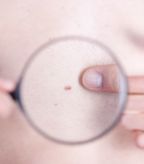Young White Men More Likely Than Women to Die from Melanoma
Adolescent and young white men are at a more than 50% increased risk for death from melanoma than women of the same age, a new study has found. The researchers called the difference “alarming.”
Adolescent and young white men are at a more than 50% increased risk for death from melanoma than women of the same age, a new study has found. The researchers called the difference “alarming,” and said that it warrants increased use of behavioral interventions to promote early detection strategies in this patient population.

“Studies worldwide have demonstrated that women diagnosed with melanoma tend to fare better than men in terms of improved survival,” said Susan M. Swetter, MD, study author and director of the pigmented lesion and melanoma program at Stanford University Medical Center. “This has mostly been attributed to better screening practices and behaviors in women that result in thinner, more curable tumors, and/or more frequent physician visits in older individuals that result in earlier detection.”
In the study, published in JAMA Dermatology, Dr. Swetter and colleagues focused on survival differences between young men and women aged 15 to 39 years diagnosed with cutaneous melanoma, who constitute a generally healthy population compared with the older adults that have usually been studied.
Using the SEER network of cancer registries, the researchers collected data on 26,107 non-Hispanic white adolescents and young adults with melanoma of the skin. Patients had been followed for a mean of 7.5 years.
During that time, 1,561 melanoma-specific deaths occurred. Although the patient population was only 39.8% men, 63.6% of deaths from melanoma occurred in men, the study found. After adjusting for factors including tumor thickness, histologic subtype, and metastasis, young men had a 55% increased risk for death from melanoma (HR = 1.55; 95% CI, 1.39–1.73) compared with women.
“Our findings are particularly timely as a 2012 pooled analysis of four European Organisation for Research and Treatment of Cancer phase III trials found that women with melanoma had a 30% survival advantage compared to men, despite similar clinical follow-up and treatment through randomized trials,” Dr. Swetter told Cancer Network. “A more recent European analysis demonstrated a persistent, independent female survival advantage even in patients with advanced melanoma, though most patients in these studies tended to be older.”
The researchers also found that men within each specific age group studied (15–24 years, 25–29 years, 30–34 years, and 35–39 years) were more likely to die from their melanoma than matched women of the same age. Furthermore, even among men with melanoma less than 1 mm thick, this increased risk for death persisted.
“Our results present further evidence that a biologic mechanism may contribute to the sex disparity in melanoma survival, especially since adolescent and young adults see physicians less frequently and are less likely to have sex-related behavior differences in skin cancer screening practices than older individuals,” Dr. Swetter said.
Recent education efforts have focused on adolescent and young women through avoidance of tanning beds and outdoor tanning practices. Based on the results of the study, the researchers recommended that adolescent boys and young men be educated about the dangers of skin cancer.
“A similar message to adolescent and young adult men that emphasizes that they tend to do worse with melanoma may help to promote early detection of any new or changing skin lesion that may represent melanoma and enhance chances for cure,” Dr. Swetter said.